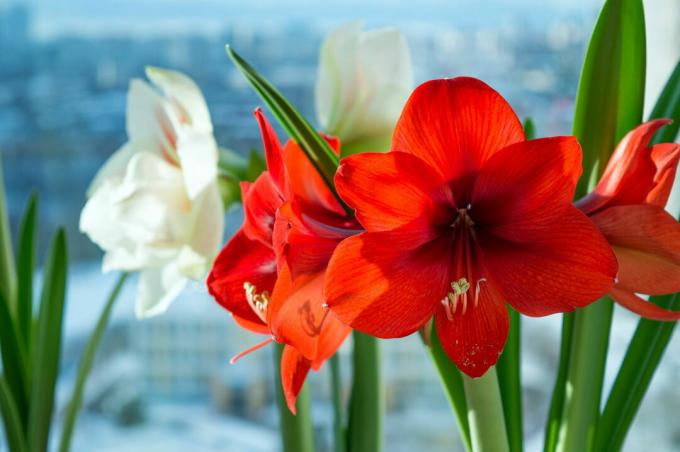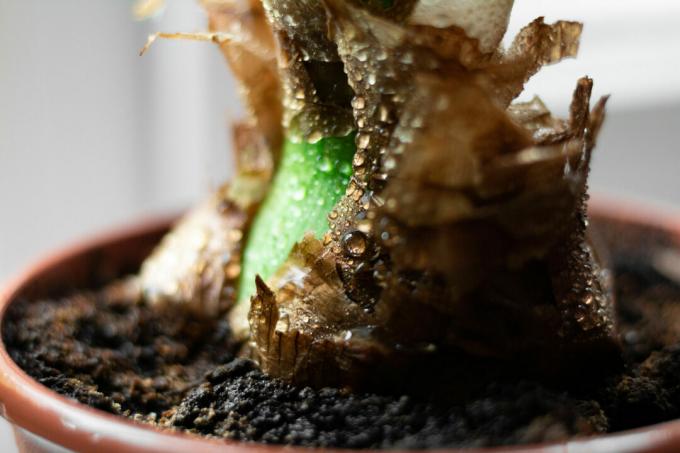Should you prune amaryllis after flowering? How should you care for amaryllis after flowering? Our tips for caring for amaryllis in summer.

In many places, the impressive species of amaryllis (Hippeastrum) also known as the knight star. The name Amaryllis bears witness to the past - the knight stars were once the Assigned to the genus Amaryllis, but now they include their own plant genus called Hippeastrum. Nevertheless, the name Amaryllis is still the most common - which is why we use it in this article. However, it is undisputed that the knight star is a perennial bulbous plant. After flowering, which usually appears from December to February, the amaryllis does not have to give way forever. If you take care of the amaryllis after flowering, it can be made to flower again next year without much effort.
contents
- Amaryllis: flowering time and care after cycles
- Should you prune amaryllis after flowering?
- Caring for amaryllis after flowering
- Caring for amaryllis in summer
Amaryllis: flowering time and care after cycles
Proper care for amaryllis requires understanding of their different life cycles throughout the gardening year. The demands of amaryllis after flowering are fundamentally different. First, however, we will show an overview of the individual life phases of an amaryllis over the course of a year:
- Flowering period: December to February
- Growth: March to August
- Rest period: August to December
How one Amaryllis in bloomt care for should, you can read here. In this article, we focus on the specific needs during the growth and dormant phases.

Should you prune amaryllis after flowering?
Once the amaryllis has finished flowering, growth really begins. In order for the plant to develop optimally, you should cut off the amaryllis after flowering. The withered flower of the amaryllis including the stem is cut off a few centimeters above the bulb. The leaves of the amaryllis, on the other hand, are not cut off after flowering. On the contrary, it is extremely important that the healthy leaves remain on the plant, as they are crucial for the plant's photosynthesis. If the leaves are cut off, the plant's nutrient reserves are often insufficient to recover from the cut.
Caring for amaryllis after flowering
After the amaryllis has been cut off after flowering, the development of the leaves progresses and the need for water and nutrients increases. The care of the amaryllis after flowering consists mainly of watering and supplying fertilizer. When watering, make sure that the amaryllis never dries out completely, but at the same time there should be no waterlogging. In order to ensure an optimal supply of nutrients, it is also advisable to feed the amaryllis every 14 days with a good liquid fertilizer such as Plantura bio balcony– & flower fertilizer to supply. Caring for the amaryllis after flowering is very crucial. During this time, the flowers are already being created inside the bulb - too little water and a Inadequate nutrient supply can significantly reduce the willingness of the amaryllis to bloom in the coming winter reduce. In addition, a sufficiently bright location is particularly important for the development of the Amaryllis: Am It is best if the amaryllis remain in a warm and now also sunny place in the house may stay. As soon as there is no longer any threat of frost from mid-May, the Amaryllis will do very well if it is placed outside. Alternatively, it can also be planted in the bed.

Summary – How to care for amaryllis after flowering:
- February: Cut off dried flower shoots just above the bulb and leave the amaryllis in a warm and now also bright location.
- May to July: Bring the amaryllis outside when the danger of frost has banished.
- Ensure that the amaryllis is adequately watered after flowering.
- Supply with a liquid flower fertilizer every two weeks.
Caring for amaryllis in summer
At the end of July to the beginning of August, you should stop watering and fertilizing the amaryllis - this is how the dormant phase is initiated. The dormant phase is necessary to allow the amaryllis to thrive later and to elicit the impressive flowers. The leaves dry up due to the lack of water. These are then cut off and the onion can now be moved to a cool and dark place in dry soil - for example in the cellar. However, the temperature should never drop below zero. A room temperature of around 15 °C is ideal. In November it's time to repot the bulb into new substrate and prepare it for flowering. The onion is removed from the old pot and transferred to new substrate. The top third should look out of the ground when planting and the onion in the pot should have one to two centimeters of space in all directions.
If small bulbs have formed on the large amaryllis bulb, they can now be easily removed and planted individually. After one to two years of development, these self-propagated Amaryllis offspring will also flower. Other ways you die Propagating amaryllis can, we present to you in our special article.
If you want the amaryllis to flower in time for Christmas, you should water them lightly at the end of November to the beginning of December and put them in a reasonably light and warm place in the house. The dormant phase is over and the forcing of the amaryllis has begun. You can find out which specific requirements the plant has during flowering in our special article on Amaryllis care read.

Summary – Getting Amaryllis Over the Summer:
- Stop watering and fertilizing from the end of July
- Carefully remove dried leaves from the plant
- Store amaryllis in a cool and dark place
- Transplant into new substrate in early November
- At the beginning of December, moisten the amaryllis and bring it to a light spot
The amaryllis not only looks good in a pot - the plant is also charming when cut off. tips for Amaryllis as a cut flower you'll find here.



